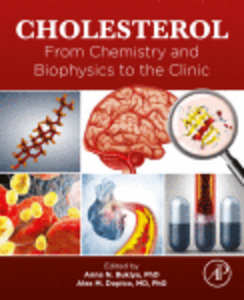Por favor, use este identificador para citar o enlazar este ítem:
https://repositorio.uca.edu.ar/handle/123456789/14433| Título: | Cholesterol-recognizing amino acid consensus motifs in transmembrane proteins: Comparative analysis of in silico studies and structural data | Autor: | Azzaz, Fodil Chahinian, Henri Yahi, Nouara Di Scala, Coralie Baier, Carlos J. Barrantes, Francisco José |
Palabras clave: | COLESTEROL; AMINOACIDOS; MEMBRANAS CELULARES | Fecha de publicación: | 2022 | Editorial: | Academic Press | Cita: | Azzaz, F., et al. Cholesterol-recognizing amino acid consensus motifs in transmembrane proteins: Comparative analysis of in silico studies and structural data [en línea]. En: Bukiya, A.N., Dopico, A.M. (eds.). Cholesterol. From Chemistry and Biophysics to the Clinic. Londres: Academic Press, 2022 doi:10.1016/B978-0-323-85857-1.00004-3 Disponible en: https://repositorio.uca.edu.ar/handle/123456789/14433 | Resumen: | Abstract: Cholesterol binding to proteins is a dynamic process that involves a combination of geometric, biochemical, and biophysical principles. These properties can be viewed as basic rules which govern any kind of molecular interactions. Nevertheless, cholesterol displays unique features that have made cholesterol recognition motifs in proteins remarkably convergent upon biological evolution. Consequently, simple algorithms based on consensus amino acid sequences (e.g., CARC and CRAC) have been developed to predict the presence of such cholesterol-binding motifs in proteins. The intrinsic weakness of this approach is that CARC and CRAC are both based on a linear (1D) sequence motif, whereas cholesterol-binding sites have a three-dimensional (3D) structure. This issue is discussed in detail in this chapter. We then analyze the performance of these algorithms in the light of structural data obtained by X-ray diffraction and cryoelectron microscopy of membrane proteins, and structure-function studies based on site-directed mutagenesis. Our study not only confirms the overall reliability of CARC and CRAC algorithms but also reveals new clues that could bring forth new ideas on cholesterol recognition motifs in the 3D structure of transmembrane proteins. | URI: | https://repositorio.uca.edu.ar/handle/123456789/14433 | ISBN: | 978-0-323-85857-1 | Disciplina: | MEDICINA | DOI: | 10.1016/B978-0-323-85857-1.00004-3 | Derechos: | info:eu-repo/semantics/closedAccess | Fuente: | Bukiya, A.N., Dopico, A.M. (eds.). Cholesterol. From Chemistry and Biophysics to the Clinic. Londres: Academic Press, 2022 |
| Aparece en las colecciones: | Libros o partes de libro |
Ficheros en este ítem:
| Fichero | Descripción | Tamaño | Formato | |
|---|---|---|---|---|
| thumb.gif | 13,2 kB | GIF |  Visualizar/Abrir | |
| cholesterol-recognizing-amino.pdf | 8,07 MB | Adobe PDF | SOLICITAR ACCESO |
Visualizaciones de página(s)
87
comprobado en 27-abr-2024
Descarga(s)
18
comprobado en 27-abr-2024
Google ScholarTM
Ver en Google Scholar
Altmetric
Altmetric
Este ítem está sujeto a una Licencia Creative Commons

